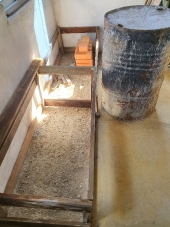
 5
5





 6
6





For all your Montana Masonry Heater parts (also known as) Rocket Mass heater parts.
Visit me at
dragontechrmh.com Once you go brick you will never go back!




 5
5




For all your Montana Masonry Heater parts (also known as) Rocket Mass heater parts.
Visit me at
dragontechrmh.com Once you go brick you will never go back!
 6
6





 3
3




 4
4




Aim High. Fail Small.
Repeat.




 1
1




For all your Montana Masonry Heater parts (also known as) Rocket Mass heater parts.
Visit me at
dragontechrmh.com Once you go brick you will never go back!
 2
2




thomas rubino wrote:Hi Jenny; While reading your post again I wanted to point out one more thing.
I'm afraid you can not try to heat those stone walls! Your inside mass must be spaced away from the stone and Ideally some form of insulation between them.
Why ? You might ask... If you try to heat those walls, they will suck up any heat and transfer it to the other side (outside). You can not heat central Portugal with an RMH :-)
 1
1




Glenn Herbert wrote:It looks like your brick extension is a few steps down from the original stone structure. What is the wall between them like? Mostly solid, or any major open space? How thick? Building your RMH in/on/against that wall would probably be your best bet. How thick is the stone wall there? You would benefit from mass, but mass that is more than a foot thick will take days to heat through. This would be fine for deep-winter climates which need heat continuously for weeks on end, but not for a place that needs warmth intermittently. The less constant the heating demand, the thinner your mass wants to be so it can be responsive within a few hours at most.
 3
3




thomas rubino wrote:Hi Jenny; Big Welcome To Permies! And another Big Welcome to the fascinating world of rocket science!
What a cool little stone "ruin" you have there!
You have the basic information, now we need to make it practical for you.
You wanted to start outdoors with a cooking J tube? This is a great idea! Better to learn outdoors. Before building indoors.
Can I assume you know the proper size to build a J tube? A 6" to cook on is plenty. If you are wanting a bench to sit on then I would build an 8" J tube.
Mass; Pebbles work ok for a quick build but do not hold heat like a solid mass. So I recommend a cob / rock filled bench.
Cob; Don't let it scare you... it is nothing but sticky mud. In a mass, after you place your horizontal pipes. You cover them with "cob" mud... then use as much larger solid rock. Bedding then in with mud so there are no air spaces.
So as you see the Cob is only a filler, and can be used as a final covering if desired. The large solid rocks are your heat holding medium. When using pebbles one might think that rock is rock but it is the air spaces between those pebbles that make them less desirable than solid rock bedded with mud.
I'll stop now so I don't overload you with information.
Write back with your answers and questions.
Our happy crew of Rocket scientists are eagerly awaiting your questions!
 1
1




Aim High. Fail Small.
Repeat.
 1
1




Eliot Mason wrote:
Paul Wheaton...) has a simple cloth wall tent (tipi) in Montana that has been successfully heated with an RMH.




Aim High. Fail Small.
Repeat.




 2
2




![Filename: 20201221_150227.jpg
Description: [Thumbnail for 20201221_150227.jpg]](/t/154725/a/130915/20201221_150227.jpg)
For all your Montana Masonry Heater parts (also known as) Rocket Mass heater parts.
Visit me at
dragontechrmh.com Once you go brick you will never go back!

 2
2








 4
4





For all your Montana Masonry Heater parts (also known as) Rocket Mass heater parts.
Visit me at
dragontechrmh.com Once you go brick you will never go back!
 1
1




Jenny Ives wrote:
End goal
* Heat a stone building with an area of 35 meters square
* No floor (dirt at the moment) and this can be whatever we need it to be. Thinking of a wooden floor.
* Not and won't be insulated.
* Built out of rocks will point with limestone mortar. Has an existing brick extension.
* Use to heat 3 months a year & dry clothes ( :-) when temperatures fall to freezing in central Portugal
* Use to heat water needs for 2 people
* Used for cooking
* No budget - will scrounge and scavenge required material




 1
1








Jenny Ives wrote:
Hi
Some food for thought.
We considered insulating but from my research we must let the rock breathe.
Also we like the look of the rock.
Will insulate floor, roof etecetera.
Thanks for your input 😄
Kind regards












We will need a new thread for stone buildings as I have much to learn. My little stone ruin is probably smaller then a typical castle's privy.Abraham Palma wrote: That's why they put carpets on old castle walls.

|
This will take every ounce of my mental strength! All for a tiny ad:
The new kickstarter is now live!
https://www.kickstarter.com/projects/paulwheaton/garden-cards
|






